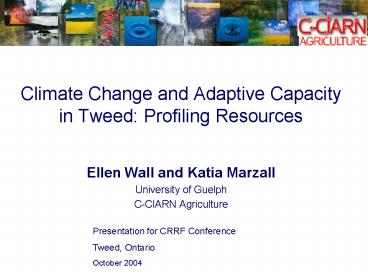Climate Change and Adaptive Capacity in Tweed: Profiling Resources - PowerPoint PPT Presentation
1 / 21
Title:
Climate Change and Adaptive Capacity in Tweed: Profiling Resources
Description:
Job diversity. Employment rates. Income level. Home ownership. Local ... Community health and services availability compared to other rural Canada sites ... – PowerPoint PPT presentation
Number of Views:26
Avg rating:3.0/5.0
Title: Climate Change and Adaptive Capacity in Tweed: Profiling Resources
1
Climate Change and Adaptive Capacity in Tweed
Profiling Resources
- Ellen Wall and Katia Marzall
- University of Guelph
- C-CIARN Agriculture
Presentation for CRRF Conference Tweed, Ontario
October 2004
2
Adaptive Capacity and Climate Change in Rural
Canada
- PURPOSE
- Assess adaptive capacity in rural communities for
meeting climate and weather risks.
3
Southern Ontario Projected Conditions (21st
century)
- Greater climate variability in general
- Warmer wetter winters
- Hotter drier summers
- Increased extreme events (extended droughts,
violent storms, hot spells)
4
Might result in increased pressure on
- Human health (heat,smog,new infectious disease)
- Services infrastructure (1 in 100 yr floods come
more often) - Water quantity/quality health of forests and
managed ecosystems - Economic opportunities Insurance
5
Adaptive capacity for climate change
- The ability of a system to adjust to climate
change (including climate variability and
extremes), to moderate potential damages, to take
advantage of opportunities, or to cope with the
consequences. (McCarthy et al 2001)
6
Adaptive Capacity depends in part on resources
available
- Social resources
- Human resources
- Institutional resources
- Natural resources
- Economic resources
7
Why Social Resources?
- Fewer people left stranded or uncared for
- Networks between communities get the word out and
assistance in - People who care about their community will ensure
it recovers.
8
Why Human Resources?
- Response to climate impacts is enhanced with
residents who have - -strong skills and ingenuity
- -good physical and mental health
9
Why Institutional resources?
- The quality of utilities infrastructure affects
severity of impact. - Political connections may enhance community
access to assistance. - Effective communications services guarantee
faster response from within and without.
10
Why Natural Resources?
- Better quality/higher quantity of affected
resources mean greater ability to withstand
climate impacts
11
Why Economic Resources?
- Greater financial assets mean more ability to
recover from material loss. - Diverse employment opportunities provide more
options if climate affects particular type of
occupation.
12
Social Human Institutional Natural Economic
Community attachment Voluntary involvement Number of community events School availability measure Dependency ratio Years of schooling completed Elected representation Age and condition of utilities Number of emergency programs available Community health and services measure Radio/tv/ares Frequency of water contamination Frequency of water shortage Quality/quantity assessment of surface water Job diversity Employment rates Income level Home ownership Local business ownership
13
(No Transcript)
14
Tweed Profile
15
Social Resources
(From Household Survey, 2001) percentage of
residents volunteering score 00 -
10100 Tweed 8
16
Human Resources
25 year trends in dependency ratio(dependents
age 0-15 gt64 adult pop. age
15-64) score 10 -DR 50 and stationary
trend 7 - DR lt 65 - gt50 and decreasing trend 5 -
DR lt 65 - gt50 and stationary trend 3 - DR gt 65 -
lt100 and increasing trend 0 - DR gt100 and
increasing trend
Tweed 3
17
Institutional Resources
Community health and services availability
compared to other rural Canada sites (hospital,
ambulance, emergency, doctors, nurses, homecare
visits, social workers, public health nurse, food
bank, youth/womens/seniors drop-in centres,
from NRE report, 2003) score 10all services
available within 30 min drive 0 no services
available Tweed 10
18
Natural Resources
Frequency of water contamination (Diverse reports
on water management for southeastern
Ontario/Hastings County/Deloro mine and Tweed
Annual Report 2003 ) score 0 no water
availability 2.5 water availability/high
potential for contamination 5 water
availability/ low potential for contamination 10
water availability/no potential for contamination
Tweed 2.5
19
Economic Resources
Local business ownership (from Tweed - Business
Retention and Expansion Survey Report,
2004) score 0 no local ownership of
business 10 100 local ownership of business
Tweed 8
20
Summary
Resource Average score Designation
Social 8.5 strong
Human 4.5 weak-moderate
Institutional 6.6 moderate
Natural 5.8 moderate
Economic 6.4 moderate
21
Questions































